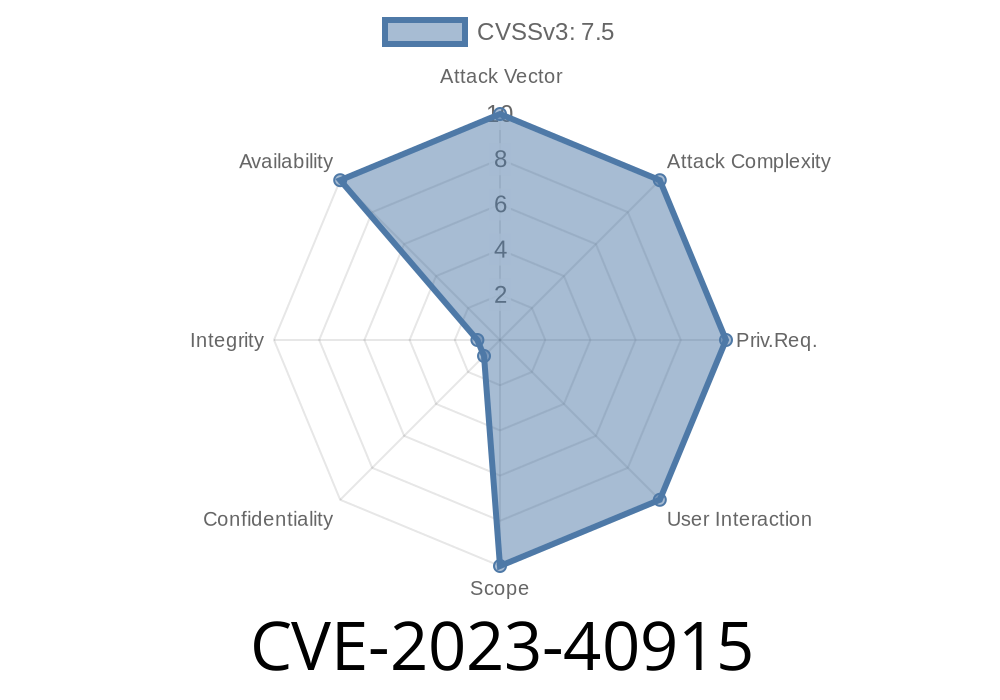The Tenda AX3, a popular Wi-Fi 6 router (model v16.03.12.11), is meant to offer blazing speeds and an easy wireless setup for home users. But in 2023, a serious vulnerability was uncovered that lets even a simple attacker take down the device. In this long-form post, I’ll break down CVE-2023-40915 in practical language, including code details, attack scenarios, and how to test and protect yourself.
1. What is CVE-2023-40915?
CVE-2023-40915 is a stack buffer overflow vulnerability in the router's web interface. It affects the endpoint called by the function form_fast_setting_wifi_set, which handles Wi-Fi configuration (like SSID name). Because the code does not properly check the length of the SSID parameter, an attacker can send a very long string and overflow memory on the device.
Impact: This leads to a Denial of Service (DoS)—the router crashes and stops providing internet. While this bug does _not_ seem to allow remote code execution out of the box, it's still highly disruptive to home and small office users.
2. How Does the Vulnerability Work?
The Tenda AX3 has a web management interface, usually at http://192.168..1/. The form at /goform/fast_setting_wifi_set lets the user (or attacker) configure the Wi-Fi network name (SSID).
Source Code Snippet (Recreation)
void __fastcall form_fast_setting_wifi_set(request *req) {
char ssid[64]; // buffer for the SSID
const char *user_ssid = http_get_param(req, "ssid");
// FLAW: does not check length of user_ssid, just copies!
strcpy(ssid, user_ssid);
// ... rest of function uses ssid ...
}
In the real firmware, a function like strcpy() is used without boundary checking. If you POST a string longer than 64 bytes to the SSID parameter, it overwrites adjacent stack memory, often making the process crash.
Network Access: You must be able to reach the router's web interface (usually on local network).
- No Authentication Bypass Required: If the router is not protected (no admin login), anyone can exploit it. Otherwise, you’d need admin access.
You can use curl or a custom script. Here’s a simple command line way to trigger the bug
curl -X POST http://192.168..1/goform/fast_setting_wifi_set \
-d "ssid=$(python3 -c 'print("A"*200)')"
4. References
- Original NVD Entry for CVE-2023-40915
- Security Research Advisory (Chinese)
- Firmware Download for Tenda AX3
- Exploit thread on seclists.org (example)
> Note: Always test on your own equipment in a safe environment. Attacking other people's routers is illegal.
5. How to Protect Yourself
- Update Firmware: Tenda may have released a patch (always check official support for your exact model).
- Restrict Access: Don't expose router admin interfaces to the internet. Restrict access to trusted users only.
- Strong Passwords: Always use complex admin passwords—it won’t stop this bug itself, but prevents unwanted access.
6. Conclusion
CVE-2023-40915 is a classic example of how dangerous unchecked user input can be, even in home networking gear. With just a single HTTP request, a local attacker can kick everyone offline. If you use a Tenda AX3, make sure to patch it, and never leave your router's admin panel open to the world.
Let me know if you want a custom scanning script or have questions about router security! Stay safe online.
Exclusive Tip: If you're a network admin, consider regular vulnerability testing of your own IoT/network devices. Tools like RouterSploit and Nmap scripts for HTTP exploits can help automate checks for old and new router bugs.
Timeline
Published on: 08/25/2023 15:15:09 UTC
Last modified on: 08/29/2023 16:11:13 UTC
